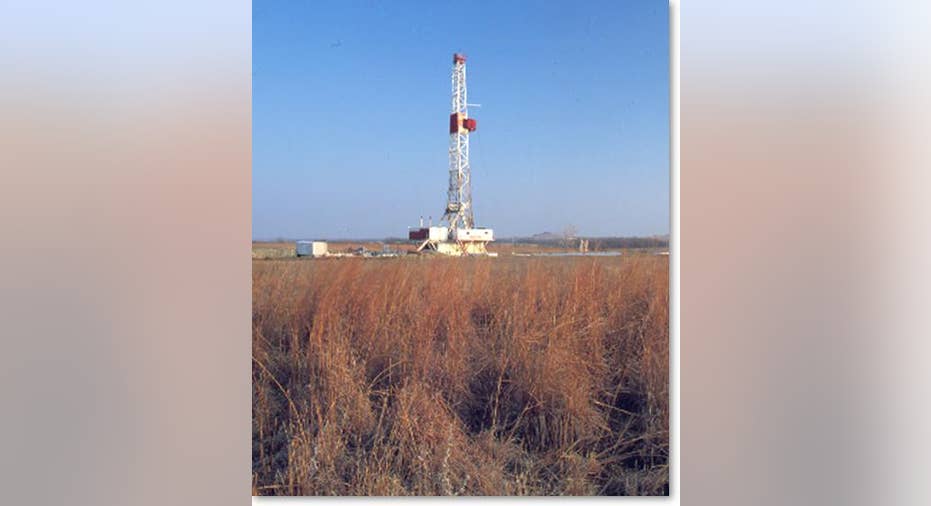1 Oil Play to Watch in 2016

Image source: Newfield Exploration.
America's oil boom has undergone a lot of changes over the past few years. What started out as a North Dakota-focused boom quickly spread to Texas, and then to the Rockies and Oklahoma. And, while the downturn in oil prices has clearly slowed the boom in many of those places, low oil prices haven't completely extinguished the enthusiasm over what's still to come.
That's pretty clear by listening to oil executives' comment on the latest oil play that's catching their eye: The Sooner Trend Anadarko Basin Canadian andKingfisher Counties, more commonly known as the STACK play of Northern Oklahoma.
An important trend this quarterLost in all of the headlines surrounding weakening oil prices is the emergence of the STACK play and its potential to create value for oil companies. It's a play that a handful of companies are turning their attention to because of the strong drilling returns they are seeing amid weak oil prices.
Newfield Exploration , for example, which also operates in the Eagle Ford and Bakken, noted last quarter that it has "shifted both people and capital resources to our highest return asset -- the Anadarko Basin" with a priority of "holding our economically resilient STACK acreage by production."
Meanwhile, Devon Energy , which operates in the Eagle Ford and Permian Basin recently spent $1.9 billion to bulk up on its position in the STACK play. Even Chesapeake Energy spent time on its third-quarter conference call talking up its STACK acreage, calling it "one of the most undervalued assets in our portfolio."
The reason Newfield Exploration, Devon Energy, and Chesapeake Energy are all very enthusiastic about the STACK is because the drilling returns are very lucrative at current oil and gas prices. For example, the STACK-focused company that Devon Energy just bought was delivering a 40% internal rate of return on its best wells at around a $40 oil price. That's a pretty compelling return, especially when some plays require double that price just to break even.
Drilling down into the STACKTo understand why these wells are so lucrative at low oil and gas prices, investors really need to understand the geology of the STACK. That's somethingContinental Resources spent a good amount of time detailing on its most recent quarterly conference call.
Continental COO Jack Stark noted that the company has only drilled a small handful of wells thus far, but it quickly discovered it was sitting on a very strong position. He pointed out five key takeaways from the company's initial tests:
- Stark said, "we're comfortable saying that the net unrisked resource potential for our STACK acreage exceeds our expectations for SCOOP Springer and could approach that of our SCOOP Woodford." In other words, the amount of oil and gas it expects to recover from the STACK is on par, if not better than its other two emerging Oklahoma oil plays.
- "...from an economic standpoint, our STACK acreage looks like it will compete head-to-head with our economics in SCOOP." Not only is the resource potential compelling, but the economic returns are strong, too.
- "...more than 95% of Continental's acreage is located in the STACK over-pressured window ... From experience, higher 90-day rates typically translate to higher EURs in tight resource plays like STACK." Because of the strong reservoir pressure, each well should produce a lot of oil and gas over its lifetime, which is known as its estimated ultimate recovery (EUR). The higher the EUR, the stronger the drilling returns.
- "...our acreage is concentrated in some of the thickest liquids rich portions of the play." This means there's more hydrocarbon-bearing rock underneath Continental's acreage than is typically found elsewhere.
- "...approximately 60% of our 146,300 net acres is already held by production." This means the company doesn't need to drill as many wells just to hold its acreage and instead can concentrate on drilling where the economics are most compelling.
The key takeaway here is that what makes the STACK so economically lucrative even at weaker oil and gas prices is the sheer volume of hydrocarbons packed in each section, which, when combined with strong pressure leads to wells that spew out robust initial production and that produce a lot of oil and gas over their lifetime. That combination leads to a faster initial payback and a long tail of income that pushes up the well return. To put it another way, a producer will get more oil and gas out of a STACK well over its lifetime than from a well that costs a similar amount, but it is drilled into a reservoir with less concentrated hydrocarbons or less pressure. That makes a huge difference when it comes to drilling returns.
Investor takeawayInvestors should expect to hear a lot more about the STACK in 2016 because it's one of the few economic plays a driller can invest in right now. That's why we're seeing companies like Devon Energy pay up to bulk up on their position, while others like Newfield Exploration, Continental Resources, and Chesapeake Energy are shifting capital to this play because it's yielding the most lucrative returns in their portfolios.
Further, while the economics are compelling right now, they'll get even better as commodity prices improve, which could lead to strong value creation in the future for drillers that have a position in the STACK.
The article 1 Oil Play to Watch in 2016 originally appeared on Fool.com.
Matt DiLallo has no position in any stocks mentioned. The Motley Fool owns shares of Devon Energy. Try any of our Foolish newsletter services free for 30 days. We Fools may not all hold the same opinions, but we all believe that considering a diverse range of insights makes us better investors. The Motley Fool has a disclosure policy.
Copyright 1995 - 2015 The Motley Fool, LLC. All rights reserved. The Motley Fool has a disclosure policy.